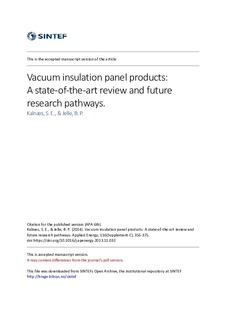| dc.contributor.author | Kalnæs, Simen Edsjø | |
| dc.contributor.author | Jelle, Bjørn Petter | |
| dc.date.accessioned | 2017-12-28T21:53:35Z | |
| dc.date.available | 2017-12-28T21:53:35Z | |
| dc.date.created | 2013-11-11T22:00:30Z | |
| dc.date.issued | 2014 | |
| dc.identifier.citation | Applied Energy. 2014, 116 355-375. | nb_NO |
| dc.identifier.issn | 0306-2619 | |
| dc.identifier.uri | http://hdl.handle.net/11250/2473840 | |
| dc.description.abstract | Vacuum insulation panels (VIP) are regarded as one of the most upcoming high performance thermal insulation solutions. At delivery, thermal conductivity for a VIP can be as low as 0.002–0.004 W/(mK) depending on the core material. VIPs enable highly insulated solutions, and a measure to reduce the energy usage in both hot-water applications, cold applications and for the construction industry in general. This study gives a state-of-the-art review of VIP products found available on the market today, and explore the future research opportunities for these products.
VIPs have been utilized with success for applications such as freezers and thermal packaging, and during the last decade they have also been used for building applications in increasing numbers, where one of the main driving forces is the increased focus on e.g. passive houses, zero energy buildings and zero emission buildings. Hence, VIPs are now in the early market stages as a building product. Implementation of VIPs in various building constructions have given an increased interest in the possibilities of this product, both in new and refurbished constructions. Even though there is not enough data to conclude the effect over a lifetime of a building yet, the immediate result in decreased energy usage can be seen. However, the problem of guaranteeing a set lifetime expectancy, along with high costs, are some of the major reasons why VIPs are met with scepticism in the building industry. Aiming to give better quality assurance for the users, make further advances in envelope technologies and the development of core materials, along with a further cost reduction, are crucial aspects for VIPs to become a competing thermal insulation solution for buildings. | nb_NO |
| dc.description.sponsorship | Acknowledgements. This work has been supported by the Research Council of Norway and several partners through The Research Centre on Zero Emission Buildings (ZEB). | nb_NO |
| dc.language.iso | eng | nb_NO |
| dc.publisher | Elsevier | nb_NO |
| dc.rights | Attribution-NonCommercial-NoDerivatives 4.0 Internasjonal | * |
| dc.rights.uri | http://creativecommons.org/licenses/by-nc-nd/4.0/deed.no | * |
| dc.subject | Vacuum insulation panel; VIP | nb_NO |
| dc.subject | State-of-the-art | nb_NO |
| dc.subject | Review | nb_NO |
| dc.subject | Energy | nb_NO |
| dc.subject | Thermal insulation | nb_NO |
| dc.title | Vacuum Insulation Panel Products: A State-of-the-Art Review and Future Research Pathways | nb_NO |
| dc.type | Journal article | nb_NO |
| dc.type | Peer reviewed | nb_NO |
| dc.description.version | acceptedVersion | nb_NO |
| dc.rights.holder | © 2014 Elsevier. All rights reserved. This is the authors' accepted and refereed manuscript to the article, post-print. Released with a Creative Commons Attribution Non-Commercial No Derivatives License. The final publication is available at https://doi.org/10.1016/j.apenergy.2013.11.032 | nb_NO |
| dc.subject.nsi | VDP::Technology: 500 | nb_NO |
| dc.source.pagenumber | 355-375 | nb_NO |
| dc.source.volume | 116 | nb_NO |
| dc.source.journal | Applied Energy | nb_NO |
| dc.identifier.doi | 10.1016/j.apenergy.2013.11.032 | |
| dc.identifier.cristin | 1064670 | |
| dc.relation.project | Norges forskningsråd: 193830 | nb_NO |
| cristin.unitcode | 7401,30,40,0 | |
| cristin.unitname | Arkitektur, byggematerialer og konstruksjoner | |
| cristin.ispublished | true | |
| cristin.fulltext | original | |
| cristin.fulltext | postprint | |
| cristin.qualitycode | 1 | |

